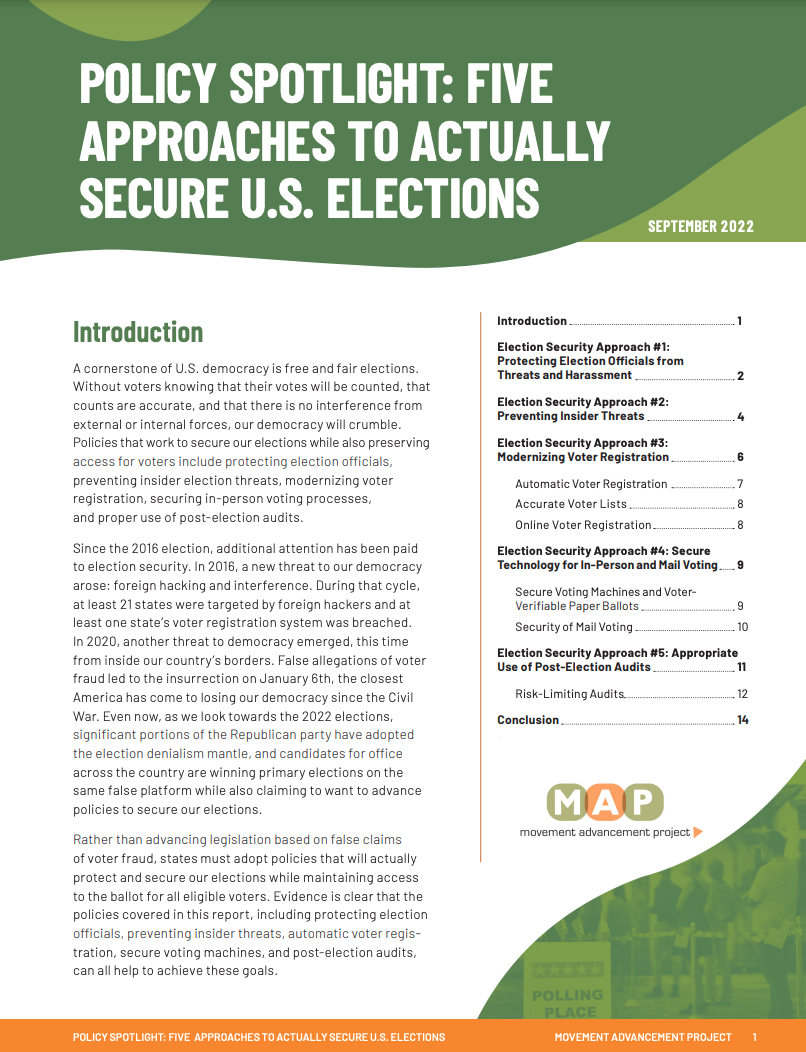Policy Spotlight: Five Approaches to Actually Secure U.S. ElectionsDownload
Policy Spotlight: Five Approaches to Actually Secure U.S. Elections
details five policy approaches that states should adopt to truly secure elections, while also ensuring that every eligible voter is able to easily cast their vote.Election Security Approach 1: Protecting election officials from threats and harassment The MAP report outlines the ways that horrific threats to election officials and their families – including death threats – have resulted in a mass exodus of qualified, experienced officials. MAP’s Democracy Maps show that only three states (Colorado, Oregon, and Maine) have enacted laws that provide additional protections to election officials.
Election Security Approach 2: Preventing Insider Threats
The security and integrity of our elections have been threatened by bad faith actors working on the inside to sabotage election equipment and potentially impact election results. For example, election officials have granted unauthorized access to voter information and election results to political operatives. The resulting breaches have occurred in at least five states, including Colorado, Georgia, Michigan, Ohio, and Pennsylvania.
States could enact laws – like Colorado did this year to increase election security by increasing penalties for facilitating authorized access to voting equipment and ensuring proper monitoring of voting equipment and systems. The federal Cybersecurity and Infrastructure Security Agency has also advised all states to adopt policies similar to those in Colorado.
Election Security Approach 3: Modernizing Voter Registration
Three key policies can modernize voter registration while improving election security, increasing access, and lowering barriers to voting: automatic voter registration, ensuring the accuracy of voter rolls, and online voter registration.
Election Security Approach 4: Secure Technology for In-Person Voting and Voting by Mail
For in-person voting, the use of voter-verified paper ballots is a core way to ensure the security of voting machines and guard against interference. In 37 states, the majority of voters can use secure voting machines with a verifiable paper trail, as tracked on our Democracy Maps.
Online ballot tracking is an important way that states can further improve the security of mail voting. Nearly every state allows voters to track the status of their vote by mail ballot. Only five states – Illinois, Mississippi, Missouri, Texas, and Wyoming – don't allow all voters to track the status of their mail ballot.
Election Security Approach 5: Appropriate Use of Post-Election Audits
Truly independent and nonpartisan audits following an election are a best practice in election administration – assuming that those audits are legitimate and truly nonpartisan. 39 states already require routine post-election audits that are nonpartisan.
An additional method to ensure the security and integrity of elections is through risk-limiting audits, which use statistical methods to analyze samples of ballots to ensure the accuracy of election results. Currently only 12 states conduct best-practice risk-limiting audit
Recommended citation:Movement Advancement Project. September 2022.
Policy Spotlight: Five Policy Approaches to Actually Secure U.S. Elections. www.mapresearch.org/Election-Security-Report-2022. [Date of access].


